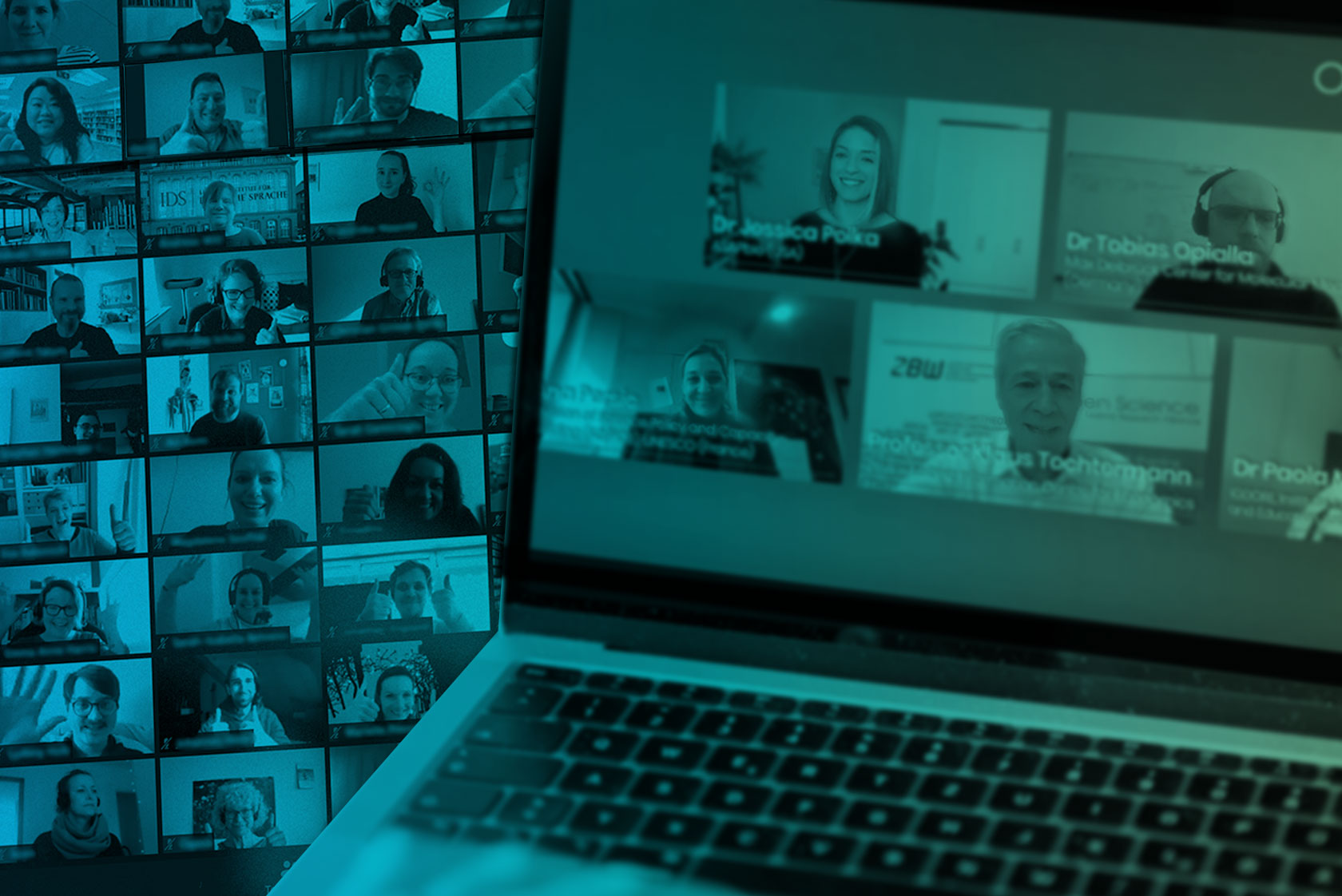
Open Science Conference 2022: New Challenges at the Global Level
What were the focal points of the Open Science Conference 2022? Which topics are currently of greatest concern to the international Open Science community? Which best practice examples can we learn the most from? And what role did UNESCO play in the global Open Science discourse? We take a look at the highlights and special features of the once again all-digital #OSC2022.
by Guido Scherp, Doreen Siegfried and Claudia Sittner
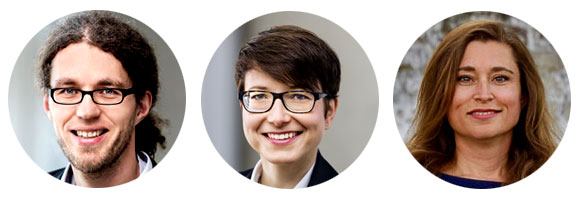
The Open Science Conference 2022 was more international than ever before. Almost 300 participants from 49 countries followed the 10 presentations and the panel discussion on the latest developments in the increasingly global Open Science ecosystem. While the talks often focused on the macro-level of the science system, additional 13 poster presentations took visitors to many best practice examples in different corners of Europe. Those who could not be there live could follow #OSC2022 on Twitter or watch the video recordings of the talks and presentations afterwards.
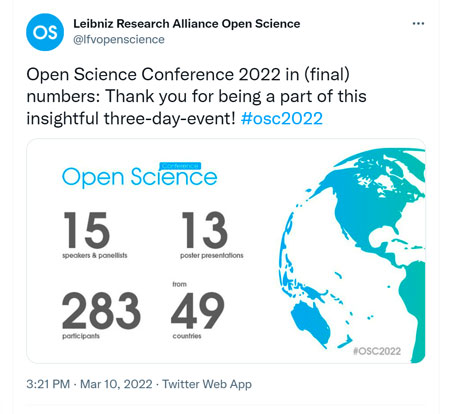
Tweet Leibniz Research Alliance Open Science: Thank you for being a part of this insightful three-day-event!
This year there was a cooperation with the German Commission for UNESCO (DUK). In the context of the UNESCO Recommendation on Open Science, which have been adopted at the end of 2021, the DUK organised a panel discussion and a workshop. The global perspective on Open Science associated with the recommendation has certainly contributed to greater internationalisation, especially outside Europe.
Professor Klaus Tochtermann, chair of the conference, emphasised in his opening address that much has happened in the Open Science movement since the last OSC in 2021. For example, the EU now requires a clear commitment to support open practices in research proposals in the Horizon Europe framework programme. The EU had already put the topic of Open Science on the research agenda in 2015. At that time, the focus was on Open Innovation, Open Science and Open to the World. In addition, the EU Commission recently launched an initiative to reform the existing system of research evaluation.
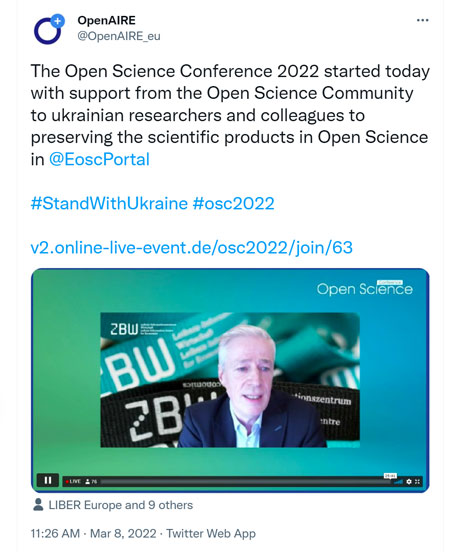
Tweet OpenAire: #StandWithUkraine
In view of the Ukraine war, Tochtermann also emphasised the importance of value-driven science diplomacy and freedom of science, in which global cooperation plays a central role.
Current challenges of the Open Science transformation
Once again, many “classics” were represented at this year’s conference. These included contributions on the latest developments in the fields of research data, societal participation and science communication. However, some conference contributions this year addressed points of contact between Open Science and other areas and showed how strongly Open Science is ultimately interwoven with a fundamental transformation of the science system. Openness alone does not solve all the problems in the global and interlinked academic sector, but it does show which barriers in the science system are currently hindering the implementation of Open Science. It is also important to keep an eye on the unintended negative effects of this transformation.
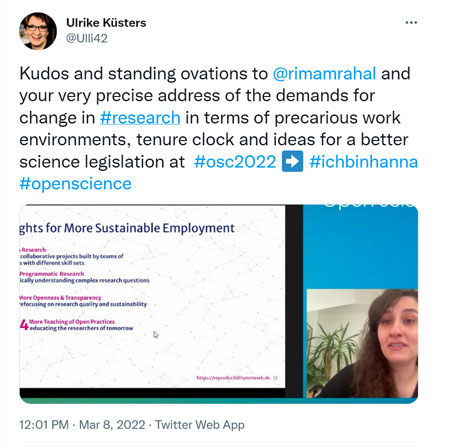
Tweet Ulrike Küstes: Kudos and standing ovations to @rimamrahal and your very precise addresses of the demands for change in #research in terms of precarious work environments, tenure clock and ideas for a better science legislation at #osc2022
In her presentation “On the Importance of Permanent Employment Contracts for Research Quality and Robustness”, Rima-Maria Rahal discussed how much research quality suffers under current working conditions. These include, on the one hand, temporary positions and the competitive pressure in the science system. In Germany, this is currently characterized by the #IchBinHanna debate (German) on Twitter. On the other hand, the misguided incentive system with its focus on the impact factor complicates the situation for many researchers. Ultimately, these framework conditions also hinder the implementation of Open Science on a broad scale. Improving research practice offers the opportunity to initiate structural changes in favour of research quality and to link them to open principles such as reproducibility, transparency and collaboration.
In his presentation on “Data Tracking in Research: Academic Freedom at Risk?”, Joschka Selinger addressed the general development that scientific publishers are increasingly offering services for the entire research cycle. Against the backdrop of the Open Access development, they are transforming their business model from a pure content provider to a data analytics business (see DFG position paper).
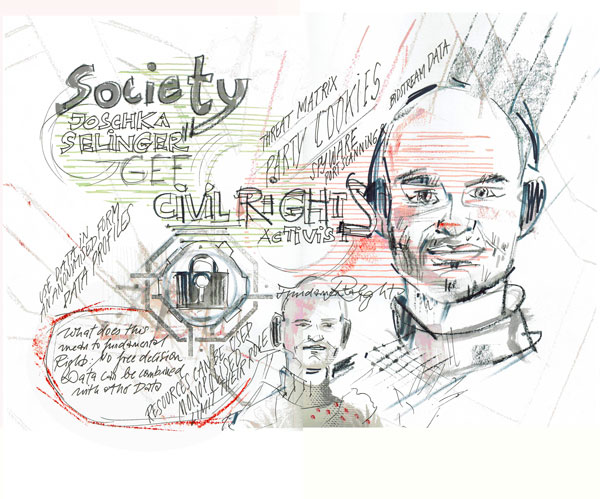
Joschka Selinger, graphic: Karin Schliehe at Open Science Conference
This privatisation of science combined with the (non-transparent) collection and exploitation of “research behaviour” is problematic for academic freedom and the right to informational self-determination, as Felix Reda also recently pointed out in a contribution to MediaTalk. Therefore, awareness of this problem must be raised at scientific institutions in order to initiate appropriate measures to protect sensitive data.
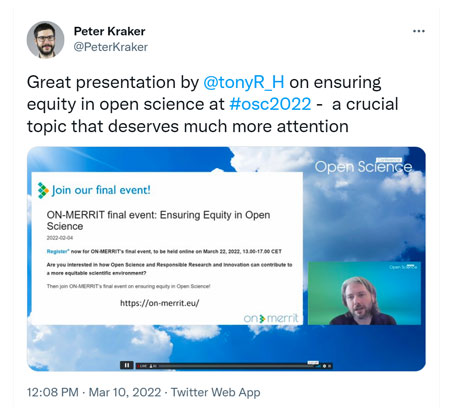
Tweet Peter Kraker: Great Presentation by @tonyR_H on ensureing equity in open science at #os2022 – a crucial topic that deserves much more attention
In his presentation “Mitigating risks of cumulative advantage in the transition to Open Science: The ON-MERRIT project”, Tony Ross-Hellauer addressed the question of whether Open Science reinforces existing privileges in the science system or creates new ones. Ultimately, this involves factors such as APC fees that make participation in Open Science more difficult and turn it into a privilege or “cumulative advantage” for financially strong countries. These factors were examined in the Horizon 2020 project ON-MERRIT and corresponding recommendations were published in a final report. In addition to APCs, this also addresses the resource intensity of open research as well as reward and recognition practices.
The global perspective of Open Science
It became clear that a central element of the further development of Open Science is in any case the “UNESCO Recommendation on Open Science”. This recommendation has particularly shaped the global perspective on Open Science and expanded it to include aspects such as inclusivity, diversity, consideration of different science systems/cultures and equity. This became particularly clear in the panel of the German UNESCO Commission on “Promoting Open Science globally: the UNESCO Recommendation on Open Science“.
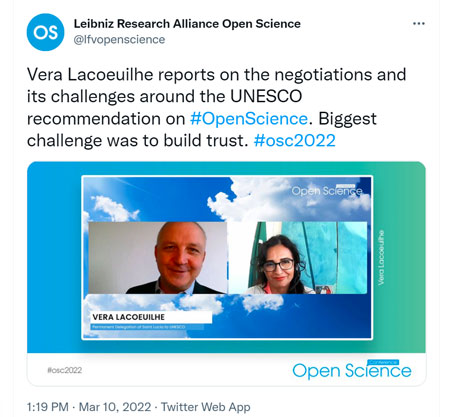
Tweet Leibniz Research Alliance Open Science: Vera Lecoeuilhe reports on the negotiations an its challenges around the UNESCO recommendation on #OpenScience
In keynote speeches, Vera Lacoeuilhe, Peggy Oti-Boateng and Ghaith Fariz gave insights into the background of the recommendation and the process behind it. Negotiating such a recommendation is extremely difficult. This is despite the fact that it does not even result in legislation, but at most requires monitoring/reporting. In the end, however, there was a great consensus. The Corona pandemic has also shown how important open approaches and transnational collaborations are to overcome such challenges – even though it was a great challenge to create an atmosphere of trust in online meetings. Finally, the process leading up to a recommendation was itself inclusive, transparent and consultative in the spirit of Open Science: The text was also available for public comment in the meantime.
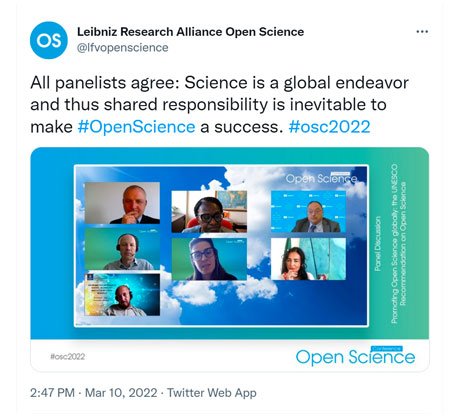
Tweet Leibniz Research Alliance Open Science: All panelists agree: Science is a global endeavor and thus shared responsibility is inevitable to make #OpenScinence a sucess
In the discussion that followed, it became very clear what great expectations and demands there are with regard to the topics of inclusion and equity. The panellists agreed that there must be a change: away from “science for a chosen few” to “science for all”. Access to science and the benefits of scientific progress must be guaranteed for all.
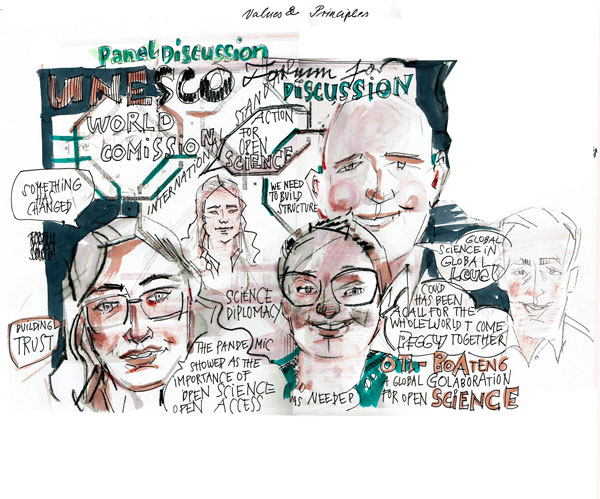
Panel discussion, graphic: Karin Schliehe at Open Science Conference
The issue of equity was strongly addressed using the example of the African continent (for example in the context of APCs). However, the discussion also focused on the outreach of the recommendation, the global dynamics it triggered, and a collective vision for Open Science. And finally, science was seen as central to achieving the UN Sustainable Development Goals (SDGs). Open Science plays a crucial role in this.
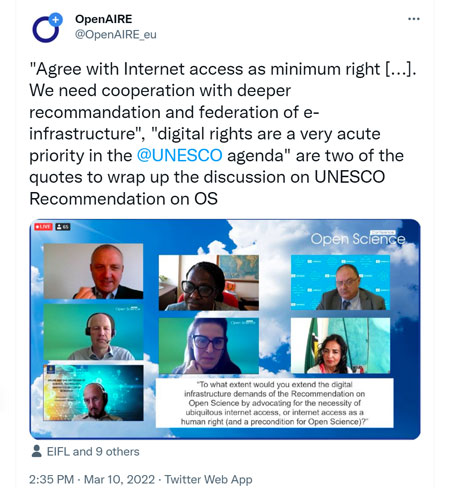
Tweet OpenAire: Agree with Internet access as minimum right
The implementation of the recommendation will now continue in working groups, the panellists reported. The topics include funding, infrastructure, capacity building and the above-mentioned monitoring. There are already some activities for the implementation of Open Science in African countries: Eleven of these best practice examples were presented at the end of the conference at the UNESCO workshop “Fostering Open Science in Africa – Practices, Opportunities, Solutions” (PDF). Anyone who would like to contact the DUK in the context of implementing the recommendation or in relation to Open Science activities is welcome to reach out to Fatma Rebeggiani (email: ).
Latest Open Science developments and best practices
Although the global view played a major role at this year’s Open Science Conference, there were again many insights into local projects, several Open Science communities and best practice examples. Especially in the poster session with its 13 contributions, it was easy to get into touch with local project leaders about their challenges in implementing Open Science.
Refreshing as always was the presentation of new projects and approaches, for example the grassroots initiative by students for students, which we reported on here on MediaTalk. Representing the student-volunteer-led initiative, Iris Smal, Hilbrand Wouters and Christeen Saparamadu explained why it is so important to introduce students to the principles of Open Science as early as possible.
Another best practice example showed how an initiative of the Helmholtz Association is proceeding to “liberate data”. Through services, consultations or with the help of tools, researchers are supported there in the management or provision of research data. Efficient handling of metadata or knowing where to find data from different disciplines are also relevant here, Christine Lemster, Constanze Curdt and Sören Lorenz explained in their poster.
The insights into the first six months of Open Science at UNC-Wilmington (North Carolina, USA) by Open Science pioneers Lynnee Marie Argabright and Allison Michelle Kittinger were also exciting. Two completely new roles were created for the two of them: that of data librarians. The goal is to build a sustainable Open Science campus across disciplines. An important concern of the two Open Science newcomers is also to raise awareness of the research data life cycle.
Insights into how the Open Science movement is progressing in different countries have also become an integral part of the repertoire of the Open Science Conference. This time, projects from these countries were presented at the poster session:
- From Slovakia, Zuzana Stožická, Silvia Sofianos, Mária Habrmanová, Matej Harvát and Jitka Dobbersteinová reported on “Promoting and Educating on Citizen Science in the Context of a Small Central European Country”, where a five-part course was developed that could well serve as a blueprint for others;
- From Greece, Athanasia Salamoura, Maria Frantzi and Giannis Tsakonas had prepared a poster on “Open Access in Greece: Perceptions in Academic Institutions”, presenting results of a recent survey;
- Sophie Forcadell and Adeline Rege from France presented the “French Second National Plan for Open Science: Support and Opportunities for Universities’ Open Infrastructures and Practices”;
- And Matic Bradač from Slovenia shared with all interested at #OSC2022 the “Lessons from the Open Access Campaign at the School of Economics and Business, University of Ljubljana”; which increased the usage rate of the institutional Open Access repository from 7 to 45 percent.
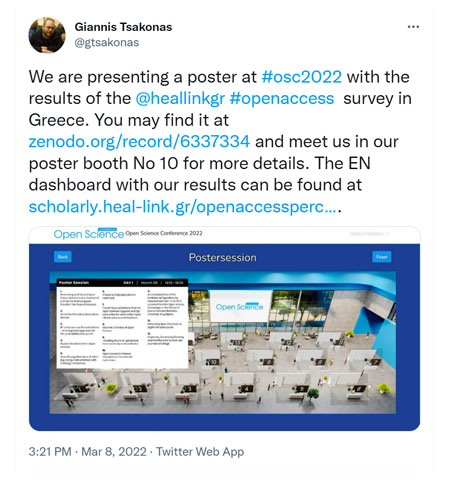
Tweet Guannis Tsakonas: We are representing a poster at #osc2022 with the results of the @heallinkgr #openaccess survey in Greece
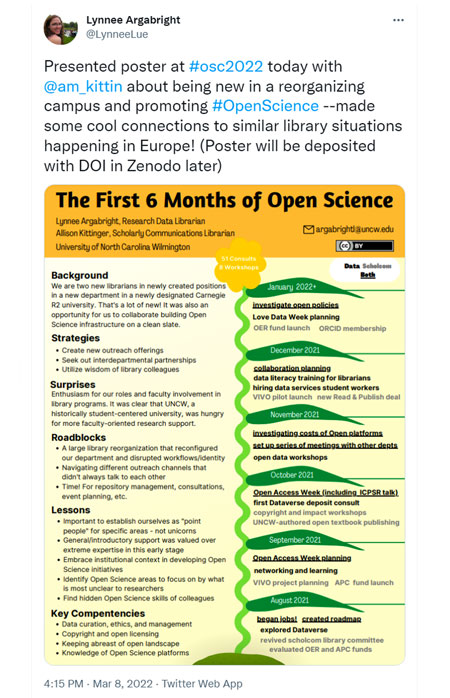
Tweet Lynnee Argabright: Presented poster at #osc2022 today with @am_kittin about being new in a reoganizing campus and promoting #OpenScience
This showed how much consideration must be given to the national or local framework conditions and country-specific sensitivities in such projects in order for them to work in the end.
Conclusion Open Science Conference 2022
This year’s Open Science Conference once again showed how the understanding of the term Open Science expands when viewed from a global perspective, and how a completely different standard emerges. Whereas principles such as transparency, openness and reusability have been the main focus up to now, UNESCO is directing the global view more towards inclusion, diversity and equity. It is becoming clear that there is not one definition and approach to Open Science, but rather many, depending on the perspective. However, the discussion about the UNESCO recommendation on Open Science has shown how important it is to agree on a few basic prerequisites in order to also meet the needs of countries from the so-called “global south”.
In any case, the global discussion is in many ways different from, for example, the European one. Nevertheless, Open Science cannot be viewed in isolation from the national or continental science system. This is certainly not a new insight, but one that was impressively demonstrated at the #OSC2022 UNESCO workshop by the many Open Science projects in African countries.
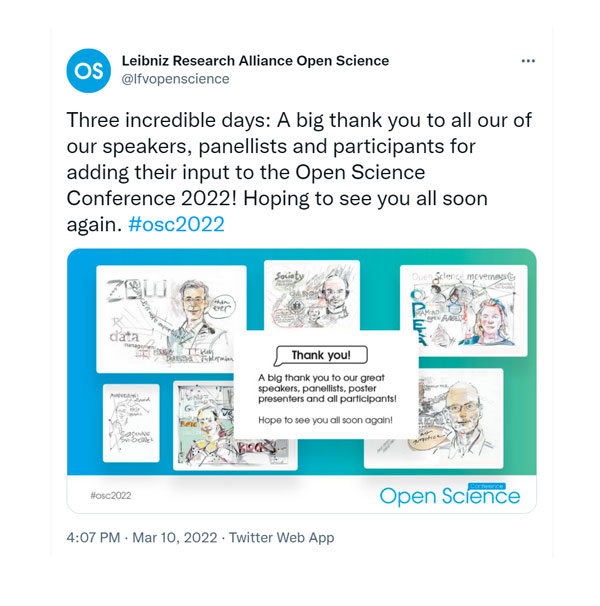
Tweet Leibniz Research Alliance Open Science: Three incredible days
Nevertheless, it is also essential to look at the world as a whole. After all, common challenges need to be overcome. The climate crisis, the fight against the global Corona pandemic or the supply of food and energy are just a few examples of why the opportunity for global cooperation should not be missed. And the gap between knowledge and science between the so-called Western countries and the global South is already too big. But if the Open Science ecosystem is to function globally, it is crucial to involve researchers from all over the world. Only in this way can the crises of our time be solved effectively and inclusively.
Web links for the Open Science Conference 2022
- Programme of the Open Science Conference 2022
- Conference slides & posters of the Open Science Conference 2022
- Speakers of the Open Science Conference 2022
- Recordings of the presentations on YouTube
- The OSC2022 in pictures: Drawings by Karin Schliehe
- Hashtag: #OSC2022
More tips for events
- ZBW-MediaTalk Events Calendar for further exciting events in the coming months
- Open Science & Libraries 2022: 22 Tips for Conferences, Barcamps & Co.
- Open Science Conference 2021: On the Way to a “New Normal”
- Barcamp Open Science 2021: Opening up New Perspectives
- Barcamp Open Science 2020: Learning to Make a Difference
- Open Science Conference 2019: The Recommendations are Being Implemented Now
- Open Science Conference 2018: Going into Practice
You may also find this interesting
- Open Science and Organisational Culture: Openness as a Core Value at the ZBW
- Open Science Podcasts: 7 + 3 Tips for Your Ears
- Digital Open Science Tools: How to Achieve more Openness Through an Inclusive Design
Dr Guido Scherp is head of the “OpenScienceTransfer” department at the ZBW – Leibniz Information Centre for Economics. He can also be found on LinkedIn and Mastodon.
Portrait: ZBW©, photographer: Sven Wied
Dr Doreen Siegfried is Head of Marketing and Public Relations. She can also be found on LinkedIn and Twitter.
Portrait: ZBW©
Claudia Sittner studied journalism and languages in Hamburg and London. She was a long time lecturer at the ZBW publication Wirtschaftsdienst – a journal for economic policy, and has been the managing editor of the blog ZBW MediaTalk. She is also a freelance travel blogger, speaker and author. She can also be found on LinkedIn, Twitter and Xing.
Portrait: Claudia Sittner©
View Comments
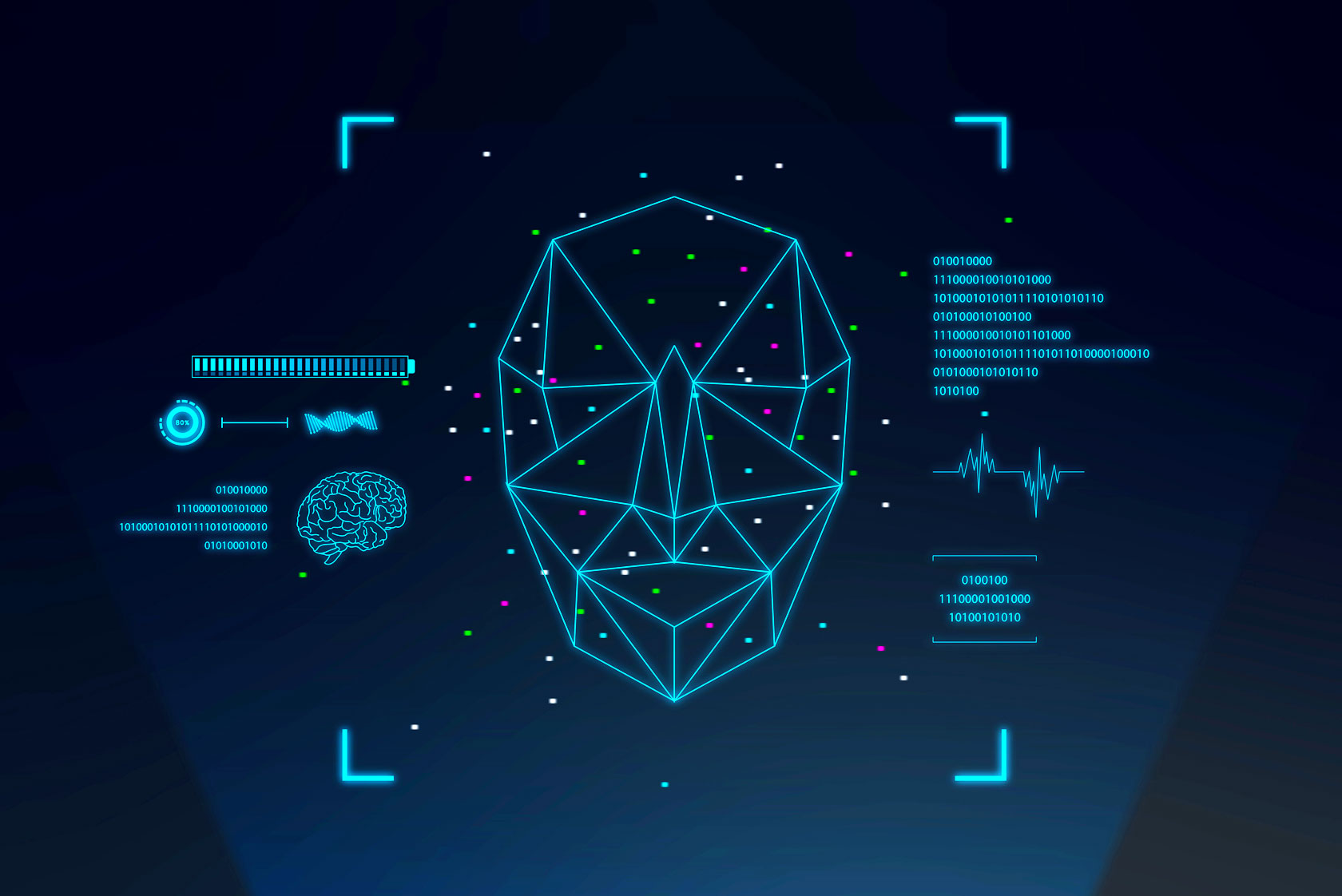
Discrimination Through AI: To What Extent Libraries are Affected and how Staff can Find the Right Mindset
Artificial intelligence (AI) has become an indispensable part of the modern...



